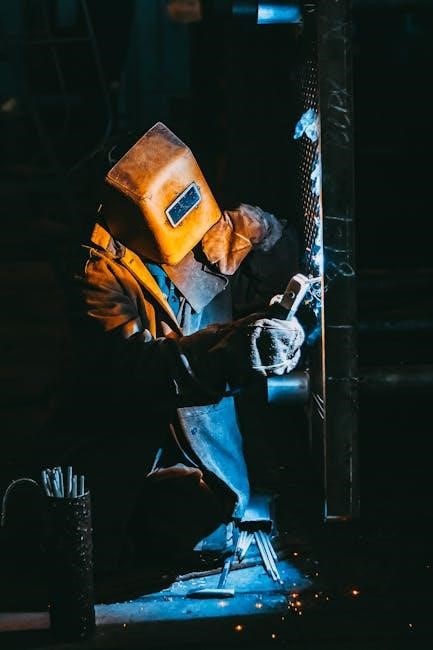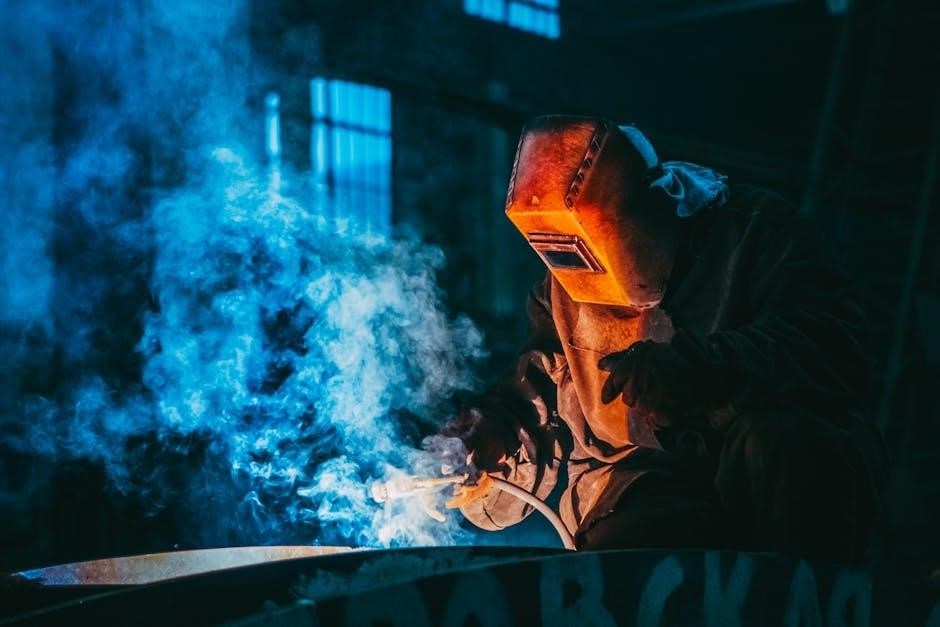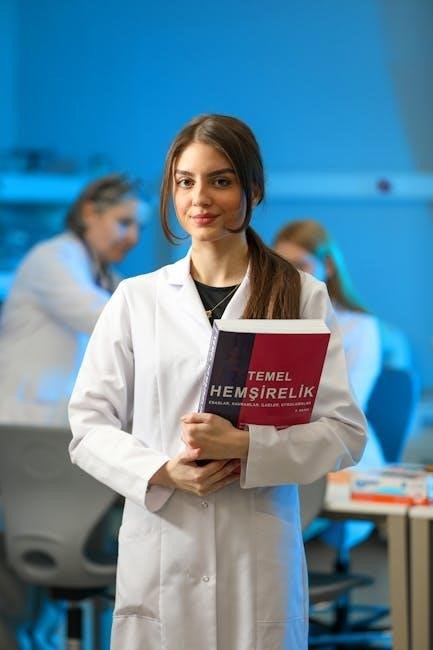Welding is a fundamental process in manufacturing, enabling the creation of strong, durable structures and machinery. Textbooks provide comprehensive resources for education and training, ensuring systematic learning and skill development in welding techniques and safety protocols, essential for both beginners and professionals.
1.1. Overview of Welding as a Fundamental Manufacturing Process

Welding is a critical manufacturing process that involves joining two metal pieces by applying heat, pressure, or both. It is essential in constructing machinery, vehicles, and infrastructure. Key processes include Shielded Metal Arc Welding (SMAW), Gas Metal Arc Welding (GMAW), and Gas Tungsten Arc Welding (GTAW). Each method offers unique advantages, making welding versatile for various industries. From automotive to aerospace, welding ensures strong, durable joints, enabling the creation of complex structures. Textbooks detail these processes, providing foundational knowledge for understanding welding’s role in modern manufacturing and its applications across different sectors.
1.2. The Role of Textbooks in Welding Education and Training
Textbooks play a crucial role in welding education by providing structured, comprehensive content. They offer detailed explanations of welding processes, safety protocols, and practical techniques. These resources are designed for both students and professionals, ensuring a systematic approach to learning. Textbooks often include visual aids, such as diagrams and illustrations, to enhance understanding. They also cover theoretical principles, enabling learners to grasp the science behind welding. By referencing authoritative sources like the American Welding Society, textbooks ensure accuracy and reliability. They serve as indispensable tools for mastering welding skills and staying updated with industry standards and advancements.

Basic Welding Processes and Techniques
Welding involves joining metals through heat or pressure. Key techniques include arc welding, a primary method using an electric arc, and gas metal arc welding (GMAW), known for efficiency and versatility in various materials.

2.1. Shielded Metal Arc Welding (SMAW)
Shielded Metal Arc Welding (SMAW), also known as “stick” welding, is a widely used process. It employs a consumable electrode covered in flux, which protects the weld area from atmospheric contamination. The flux generates a shielding gas during welding, ensuring a clean and strong joint. SMAW is versatile, suitable for various metals like steel and stainless steel, and can be performed in different positions, making it ideal for both repair work and construction in diverse environments. Its simplicity and portability contribute to its popularity in industrial and field applications, providing durable and reliable welds with proper technique.
2.2. Gas Metal Arc Welding (GMAW/MIG)
Gas Metal Arc Welding (GMAW), commonly known as MIG welding, is a semi-automatic process using a continuous wire electrode. The wire, fed through a welding gun, melts and deposits metal into the joint. Shielding is provided by an inert gas, such as argon or a mix of argon and CO2, protecting the weld from contamination. GMAW is highly versatile, suitable for welding steel, aluminum, and stainless steel. It offers high welding speeds, minimal slag, and clean welds, making it ideal for automotive, manufacturing, and construction industries. Its efficiency and adaptability have made it a widely preferred method in modern welding applications.
2.3. Gas Tungsten Arc Welding (GTAW/TIG)
Gas Tungsten Arc Welding (GTAW), also known as TIG welding, employs a non-consumable tungsten electrode to produce precise, high-quality welds. Inert gases like argon or helium shield the weld area, preventing contamination. GTAW is renowned for its clean, slag-free results and is ideal for thin materials and complex joints. It is commonly used in aerospace, automotive, and sanitary applications. While GTAW requires greater skill and is slower than GMAW, its ability to join diverse metals, including aluminum and stainless steel, makes it highly valued for demanding projects where exceptional weld integrity is essential.

Advanced Welding Methods and Applications
Advanced welding techniques like plasma arc welding and laser beam welding offer precise, high-speed joining for complex materials. These methods enhance efficiency and quality in industrial applications.
3.1. Plasma Arc Welding and Cutting
Plasma arc welding (PAW) and cutting are advanced processes utilizing ionized gas to melt and join metals. PAW offers high precision, minimal distortion, and deep penetration, ideal for thin materials and intricate designs. Common applications include aerospace and automotive industries. The process is highly efficient, producing strong, clean joints with reduced porosity. Plasma cutting, a related technique, is widely used for metal fabrication, enabling accurate and fast cutting of complex shapes. Both methods rely on precise control of plasma flow and temperature, making them versatile tools in modern manufacturing.
3.2. Oxyfuel Gas Welding and Brazing
Oxyfuel gas welding (OFW) uses a high-temperature flame to melt and join metals. It is versatile, cost-effective, and suitable for various materials like steel, cast iron, and copper. Brazing, a related process, joins metals without melting the base material, using a filler with a lower melting point. Both techniques are widely used in repair, maintenance, and fabrication. OFW is particularly popular in industries requiring portability, such as construction and automotive repair. Brazing ensures strong, leak-tight joints, making it ideal for applications like plumbing and electronics. These methods are essential in diverse industrial and domestic applications.
3.3. Soldering and Its Differences from Welding
Soldering is a joining process that uses a filler material with a low melting point, typically below 450°C, to create a bond between metals without melting the base materials. Unlike welding, soldering does not require the base metals to reach their melting point, making it ideal for delicate or heat-sensitive components. Flux is often used to prevent oxidation and improve the flow of solder. Soldering is commonly used in electronics, plumbing, and jewelry making. While welding creates a strong, permanent bond, soldering offers flexibility and is suitable for applications requiring electrical conductivity or leak-tight seals.

Safety Guidelines and Best Practices in Welding
Welding requires personal protective equipment like helmets, gloves, and goggles to prevent injuries. Proper ventilation is essential to avoid inhaling hazardous fumes. Fire safety measures must always be implemented.
4.1. Personal Protective Equipment (PPE) for Welders
Personal protective equipment is crucial for welders to ensure safety during operations. Helmets with shaded lenses protect eyes from UV and infrared rays. Heat-resistant gloves prevent burns, while flame-resistant jackets and pants safeguard against sparks. Steel-toe boots and nonflammable clothing further enhance protection. Respiratory protection, such as masks, is essential in poorly ventilated areas to prevent inhalation of harmful fumes. Proper PPE not only prevents injuries but also improves workplace safety standards, making it a non-negotiable part of welding practices.
4.2. Ventilation and Fire Safety in Welding Environments
Proper ventilation is essential to remove hazardous fumes and particles generated during welding. Local exhaust systems should be used to maintain air quality. Fire safety measures, such as keeping flammable materials away and ensuring proper exits, are critical. Fire extinguishers rated for metal fires must be accessible. Regular inspections of equipment and workspaces help prevent hazards. Training personnel on emergency procedures ensures preparedness. Adequate ventilation and fire safety practices protect workers and facilities, making them indispensable in welding environments.

The Future of Welding and Its Technological Advancements
The future of welding involves innovative technologies like automation, robotics, and advanced materials, enhancing efficiency, precision, and sustainability in manufacturing processes globally.
5.1. Automation and Robotics in Modern Welding
Automation and robotics are revolutionizing welding, offering precision, consistency, and efficiency. Robotic systems, guided by advanced software, perform complex welds with minimal human intervention, reducing errors and increasing productivity. These technologies are particularly valuable in high-volume manufacturing, ensuring uniform quality and reducing costs. Additionally, collaborative robots (cobots) are being integrated to work alongside human welders, enhancing safety and workflow. The adoption of automation is expected to grow, driven by industry demands for faster and more reliable production processes, making it a cornerstone of modern welding advancements;
5.2. Emerging Materials and Their Welding Challenges
Emerging materials, such as high-strength steels, aluminum alloys, and advanced composites, present unique welding challenges. These materials often require specialized techniques to maintain their structural integrity and mechanical properties. For instance, welding high-strength steels can lead to distortion or loss of strength, while aluminum alloys may suffer from porosity or oxidation. Additionally, new alloys and smart materials demand precise control of heat input and cooling rates to avoid defects. Addressing these challenges requires innovative approaches, such as laser welding, friction stir welding, or advanced robotic systems, ensuring the materials’ potential is fully realized in modern applications.
Welding is crucial for manufacturing and construction. This textbook provides foundational knowledge. For advanced learning, explore resources like the “Arc Welding Processes Handbook” and AWS guidelines.
6.1. Key Takeaways from the Welding Textbook
The textbook emphasizes the importance of understanding welding fundamentals, including processes like SMAW, GMAW, and GTAW, and their applications. Safety protocols, such as PPE and ventilation, are highlighted as critical to preventing accidents. The manual also covers advanced techniques like plasma arc welding and soldering, distinguishing them from traditional welding methods. Additionally, it addresses the role of automation and emerging materials in modern welding, offering insights into future trends. Practical exercises and real-world examples are provided to reinforce theoretical knowledge, making it an essential resource for both students and professionals. The textbook bridges theory and hands-on practice effectively, ensuring comprehensive skill development in welding.
6.2. Suggested Resources for Advanced Learning
For deeper exploration, the Arc Welding Processes Handbook and ASM International’s Welding, Brazing, and Soldering handbook are highly recommended. These resources offer detailed insights into advanced techniques and materials. Additionally, the American Welding Society (AWS) standards provide essential guidelines for professionals. Online platforms like Litres and academic databases offer e-books on specialized topics, such as plasma welding and dissimilar joining. These resources are invaluable for professionals seeking to stay updated on the latest advancements and best practices in the field of welding.
